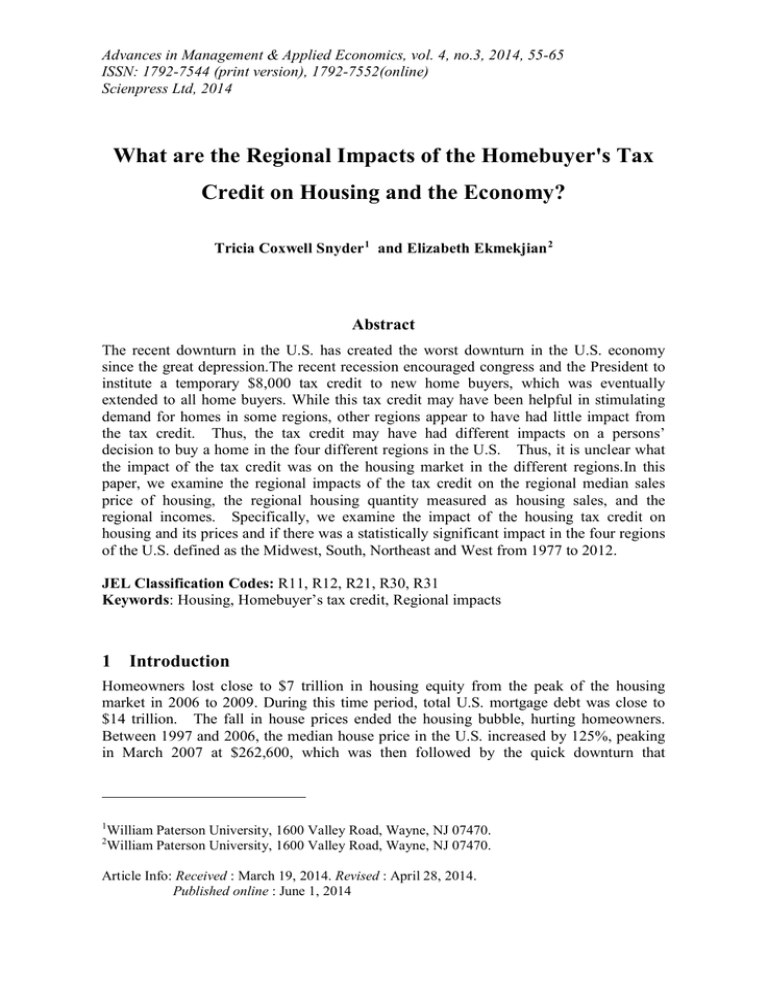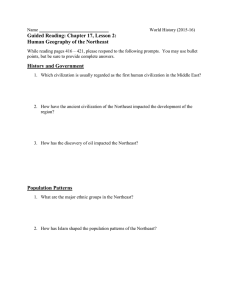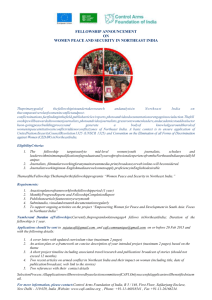Document 13727030
advertisement

Advances in Management & Applied Economics, vol. 4, no.3, 2014, 55-65 ISSN: 1792-7544 (print version), 1792-7552(online) Scienpress Ltd, 2014 What are the Regional Impacts of the Homebuyer's Tax Credit on Housing and the Economy? Tricia Coxwell Snyder 1 and Elizabeth Ekmekjian 2 Abstract The recent downturn in the U.S. has created the worst downturn in the U.S. economy since the great depression.The recent recession encouraged congress and the President to institute a temporary $8,000 tax credit to new home buyers, which was eventually extended to all home buyers. While this tax credit may have been helpful in stimulating demand for homes in some regions, other regions appear to have had little impact from the tax credit. Thus, the tax credit may have had different impacts on a persons’ decision to buy a home in the four different regions in the U.S. Thus, it is unclear what the impact of the tax credit was on the housing market in the different regions.In this paper, we examine the regional impacts of the tax credit on the regional median sales price of housing, the regional housing quantity measured as housing sales, and the regional incomes. Specifically, we examine the impact of the housing tax credit on housing and its prices and if there was a statistically significant impact in the four regions of the U.S. defined as the Midwest, South, Northeast and West from 1977 to 2012. JEL Classification Codes: R11, R12, R21, R30, R31 Keywords: Housing, Homebuyer’s tax credit, Regional impacts 1 Introduction Homeowners lost close to $7 trillion in housing equity from the peak of the housing market in 2006 to 2009. During this time period, total U.S. mortgage debt was close to $14 trillion. The fall in house prices ended the housing bubble, hurting homeowners. Between 1997 and 2006, the median house price in the U.S. increased by 125%, peaking in March 2007 at $262,600, which was then followed by the quick downturn that 1 2 William Paterson University, 1600 Valley Road, Wayne, NJ 07470. William Paterson University, 1600 Valley Road, Wayne, NJ 07470. Article Info: Received : March 19, 2014. Revised : April 28, 2014. Published online : June 1, 2014 56 Tricia Coxwell Snyder and Elizabeth Ekmekjian bottomed in March 2009 at $214,500. This reduction in home wealth transits through the economy. Strong home wealth helps to stabilize the economy and encourage an economic recovery as consumers feel more comfortable about their wealth situation and improve bank balance sheets. Thus, it may not only be the real estate market that benefits from a homebuyer’s tax credit, but other sectors benefit indirectly. Homebuyers also purchase new furniture, kitchen appliances, etc., creating spillover effects in other sectors. While the country as a whole experienced the housing bubble, it was most extreme in the west and south, with the west region experienced a decline in the median price of housing from $365,500 to $248,900, as can be seen in Figures 1. $400,000 $300,000 $200,000 $100,000 0 80 85 90 NEPRICE SOUTHPRICE 95 00 05 10 MIDWESTPRICE WESTPRICE Figure 1: Regional Housing Prices Figure 1 also shows that housing prices in the northeast and midwest have rebounded Figure 1 shows that housing prices in northeast and west are significantly higher, almost $70,000 more than those in the south and Midwest. Figure 1 also shows that housing prices in the northeast and midwest have rebounded Figure 1 shows that housing prices in northeast and west are significantly higher, almost $70,000 more than those in the south and Midwest. Figure 1 also shows that housing prices in the northeast and midwest have rebounded much faster than those in the west and south. Regional Impacts of the Homebuyer's Tax Credit on Housing and the Economy 57 1200 1000 800 600 400 200 0 80 85 90 NESALES SOUTHSALES 95 00 05 10 MIDWESTSALES WESTSALES Figure 2: Regional Housing Starts Figure 2 shows that the south had a very severe fall in housing sales starting in 2006. The south and the west region experienced the largest downturn in housing sales during the housing crisis, with home sales falling from a high of 1065 in 2006.Q1 to 276 in 2011.Q2 and 554 2005.Q3 to 107 in 2011.Q1 respectively. This downturn in housing was then followed to a much lower extreme by the Midwest and the northeast. Figure 2 also shows that at its peak home sales in the south region was more than three times the number of those in the northeast and Midwest. During the peak home sales in the west region was more than double that of the northeast. This may be due people buying second homes and retirement homes in the warmer climates during the housing bubble. This may also be due to the northeast being an older more established with a denser population. There simply may be less room to build and sell many more new homes in the northeast. Regardless of the reason, the northeast was much more stable throughout the housing bubble and burst. Results from the ANOVA Tables 1 and 2 show that the mean of the different regions are statistically significantly different with regard to both prices and sales. Results support the rejection of the null hypothesis that the means are the same, suggesting that housing prices and sales are very different in the four regions. Similar Levene test results also suggest that the variances for each region are also statistically significantly different. However, results in the correlation matrix show that while they are statistically different, that prices appear to move together. Table 3 below shows that all four regions appear to 58 Tricia Coxwell Snyder and Elizabeth Ekmekjian be highly correlated with regard to prices, while Table 4 shows that they are not highly correlated with regard to sales. Table 1: Test for Equality of Means Between Series for Prices Method Df Value Probability Anova F-statistic (3,568) 25.71080 0.0000 Analysis of Variance Source of Variation Df Sum of Sq. Mean Sq. Between 3 4.32E+11 1.44E+11 Within 568 3.18E+12 5.60+09 Total 571 3.61E+12 6.33E+09 Variable Count Mean Std. Dev. Standard Error of Mean NEPRICE 143 $194,188.1 97597.24 8161.492 SPRICE 143 $125,488.8 52778.40 4413.552 MIDPRICE 143 $135,506.3 53873.06 4505.091 WESTPRICE 143 $170,547.6 84756.84 7087.723 All 572 $156,432.7 79537.04 3325.611 Table 2: Test for Equality of Means Between Series for Sales Method Df Value Anova F-statistic (3,568) 425.8279 Analysis of Variance Source of Variation Df Sum of Sq. Between 3 19627074 Within 568 8726669 Total 571 28353743 Variable Count Mean Std. Dev. NESALES SOUTHSALES MIDWESTSALES WESTSALES All Northeast South Midwest West 143 143 143 143 572 155.1119 655.6084 271.1888 358.1713 360.1713 54.60397 187.9724 92.82772 120.5123 222.8369 Table 3: Correlation Matrix of Prices Northeast South Midwest 1 .9779 .9713 .9779 1 .9832 .9713 .9832 1 .9667 .9657 .9545 Probability 0.0000 Mean Sq. 6542358 15363.85 49656.29 Standard Error of Mean 4.566213 15.71904 7.762644 10.0777.5 9.317280 West .9667 .9657 .9545 1 Regional Impacts of the Homebuyer's Tax Credit on Housing and the Economy 59 Table 4: Correlation Matrix of Sales Northeast South Midwest West Northeast 1 .5939 .5253 .7585 South .5939 1 .6907 .8558 Midwest .5253 .6907 1 .8592 West .7585 .8558 .8592 1 While the four regions appear to move at different magnitudes and at different times, it was clear by 2008 that the housing bubble across the country was bursting. This was very concerning considering that while the housing market is only 5 percent of the overall economy, it plays a significant role in how the economy exits from recession. Especially considering that a rebound in new home building sparks demand for construction workers and building supplies and has lead the U.S. economy out of every recession since after world war II. Stabilizing the housing market was crucial to regain the confidence of America’s 75 million home owners who have a significant amount of net worth invested in their home. To help stabilize the housing market, congress acted quickly with the home buyers’ tax credit. The first measure was embodied in The Housing and Economic Recovery Act of 2008 (HERA of 2008), which provided a new refundable tax credit for first-time homebuyers of a principal residence in the United States. The residence must have been purchased between April 9, 2008 and December 31, 2008, and the maximum credit was $7,500. The American Recovery and Reinvestment Act of 2009 (ARRA of 2009), modified the credit for qualified purchases effective January 1, 2009 through November 30, 2009, increasing the maximum credit to $8,000. The 2009 Worker, Homeownership and Business Assistance Act (WHBAA of 2009), updated the 2009 changes for qualified purchases made after November 6, 2009 as follows: (1) by extending the home purchase date and allowing qualified taxpayers to enter into a binding contract before May 1, 2010 to purchase the property before July 1, 2010; (2) expanding the credit to allow long-time residents who owned and used the same principal residence for any 5 consecutive years of the last 8 years prior to purchasing a new principal residence to now qualify for a tax credit of up to $6,500; and (3) income limitations increased. The Homebuyer Assistance and Improvement Act of 2010 (HAIA of 2010), extended the closing deadline from June 30 to Sept. 30 for eligible homebuyers who entered into a binding purchase contract on or before April 30. Key provisions of these Acts are summarized in Table 5 below. 60 Tricia Coxwell Snyder and Elizabeth Ekmekjian Table 5: Homebuyers Tax Credit Act --- Eligible Taxpayer HERA of 2008 First-time home buyer ARRA of 2009 First-time home buyer WHBAA of 2009 First-time home buyer AND Long-time residents Principal residence purchased 4/9/08 to 12/21/08 1/1/09 to 11/30/09 Amount of credit 10% x purchase price with a maximum credit of $7,500 or $3,750 for MFS taxpayers 10% x purchase price with a maximum credit of $8,000 or $4,000 for MFS taxpayers Effective 11/7/2009, purchase date extended, allowing taxpayers to enter into a binding contract before 5/1/2010 to purchase the property before 7/1/2010 10% x purchase price with a maximum credit as follows: (1) for first-time homebuyers $8,000 or $4,000 for MFS taxpayers; (2) $6,500 for long-time residents Recapture of credit Credit is in essence an interest free loan as it must be repaid evenly over a 15 year period Modified Adjusted Gross Income (MAGI) Limit Credit Phaseout: the credit is reduced if MAGI is between the two sets of figures provided; if MAGI exceeds the second amount, the credit is eliminated Purchase price limitation $75,000 or $150,000 for joint filers MAGI between $75,000 and $95,000 or between $150,000 and $170,000 for joint filers Credit does not have to be repaid provided the home remains the taxpayer’s main home for 36 months after the purchase date $75,000 or $150,000 for joint filers MAGI between $75,000 and $95,000 or between $150,000 and $170,000 for joint filers $800,000 Credit does not have to be repaid provided the home remains the taxpayer’s main home for 36 months after the purchase date $125,000 or $225,000 for joint filers MAGI between $125,000 and $145,000 or between $225,000 and $245,000 for joint filers $800,000 HAIA of 2010 First-time home buyer AND Long-time residents 7/1/10 date from WHBAA extended to 9/30/10 10% x purchase price with a max. credit as follows: (1) for first-time homebuyers $8,000 or $4,000 for MFS taxpayers; (2) $6,500 for long-time residents Credit does not have to be repaid provided the home remains the taxpayer’s main home for 36 months after the purchase date $125,000 or $225,000 for joint filers MAGI between $125,000 and $145,000 or between $225,000 and $245,000 for joint filers $800,000 The intention was to spur home buying and put an end to the plunge in home prices, which were dropping at an annual rate of close to 20 percent at the time. Many estimate that 40% of all homes purchased are bought by 1st time home buyers (see Baker.)If the government could get first time homebuyers to buy a home it helps stop the slide in home prices and sales. The Real Estate industry argued that this tax credit has been vital to the recovery of the real estate market. According to the IRS 1.4 million families have already taken Regional Impacts of the Homebuyer's Tax Credit on Housing and the Economy 61 advantage of this $8000 tax credit and 1.8 are expected to participate before the program is over. The National Association of Realtors is estimating that this could create an extra 350,000 in home sales. The NAHB more conservatively predicts 165,000 more home sales than would have occurred. Using survey data, Stan Humphries estimates that the impact of extending the $8000 to new home buyers alone could have a total cost of $14.86 billion and that it would help to spur an incremental 334,000 sales (sales that would not have occurred without the credit; based on a survey, and that four of five sales of homes to first-time homebuyers would occur regardless of the tax credit). In comparison, Deutsche Bank estimates that the first-time home buyer tax credit worth up to $8,000 cost around $43,000 per home buyer, or around $15 billion for the estimated 350,000 home buyers who wouldn’t otherwise have purchased a home without the tax credit (see Dymi). The report estimates that just around 5% of all sales through mid-October wouldn’t have happened without the tax credit (or around one in five of the 1.4 million home buyers who filed for the tax credit through mid-October).According to the Government Accountability Office, 2.3 million people took advantage of the credit, at a cost to the government of $16.2 billion (see White.) While the cost of the tax credit will soon be clear, what is not clear is whether it encouraged more people to buy a home or if it just altered the timing of buying a home and in what part of the country. Fratantoni suggest that 100,000 to 300,000 people bought homes because of the first tax credit last fall who would not have bought otherwise and that the tax credit this spring should have a similar net positive effect. However, data from the National Association of Realtors in August shows that after the tax credit ended, existing-home sales dropped 27.2 percent to a seasonally adjusted annual rate of 3.83 million units in July, which is down from 5.26 million in June (see Kim.) This is 25.5 percent below the 5.14 million-unit level in July 2009. Similarly, the purchase index from the Mortgage Bankers Association shows a fall every week in May home sales, which is down 20 percent from April, when the initial tax credit ended (see Kocieniewski.) This may be due to people trying to buy homes before the tax credit ended; creating a significant fall in demand after the tax credit expired. Economists project that without the tax credit, a further 10-15 percent decline in home values that would have been another $1.5 to $2 trillion in wealth destruction for home owning families (see Daniel Hale). Many estimate that the home buyer tax credit helped to preserve about $21,000 on average for each homeowner. This wealth preservation may help to lay the foundation for a broader economic recovery in 2010 as consumers feel more comfortable about their wealth situation and greatly improve bank balance sheets. The tax credits, however, could have a differing impact on the regions of the United States. These regions are defined by the Census as the Northeast, South, Midwest, and West. One reason for the different impacts on the different regions is the large variance in the price of a home in the different regions, making $8000 is a much larger percentage of the cost of a home in the cheaper parts of the country than in the Northeast.In this paper, we will examine the impacts of the tax credit on the quantity and price of housing in the four regions of the United States. 2 Estimation Technique and Data To empirically examine the impacts of the tax credit on the housing price and sales in the four census regions, the paper regresses the median house price and sales for the northeast, 62 Tricia Coxwell Snyder and Elizabeth Ekmekjian south, Midwest and west, on the homebuyers’ tax credit controlling for other factors. Specifically, we estimate: Hou sin g = α + β C (t C ) + B P (Pr ices) + BU Unemployment + Bi ( I ) + Bloans + β r (r ) + ε i where Housing is measured as housing sales in the four regions and then as the median sales prices in the four regions, tc is the homeowners tax credit, which is a dummy variable for the quarters that they tax credit was law, r is 30 year mortgage interest rate in the region, I is personal income, u is unemployment, and loans are the number of real estate loans to capture the availability of credit, α and β ’s are parameters to be estimated, and ε i is an error term. We do this for all four census regions – northeast, south, Midwest, and west. 3 Results Results from the Anova tables suggested that the four regions have statistically different home prices and home sales. Results suggest that the tax buyer’s tax credit did not have the desired impact of increasing home sales or house prices for any of the four regions. In fact, the tax credit is either statistically insignificant or negative in its impact on the housing market. Surprisingly, Table 6 shows that the homebuyer’s tax credit has a negative and significant impact on all regions except for the northeast where it is insignificant. Housing sales are more mixed in its response to the tax credit. While it is positive for the northeast and west, it is negative for the south. However, it is insignificant for all four regions. The positive impact of the credit in the west and northeast supports results found by the White (2010) and Baker (2010). White found that the west region took the most advantage of the homebuyers tax credit more any other region. White found that California claimed the most dollars under the housing credit with $814,238,186 of dollars claimed in 2008 and $1,446,914,804 in 2009 and $414,082,835 in the first 4 months of 2010. Similarly he found that Nevada claimed the most per resident at $39.36 per resident and Utah had the highest average dollar amount for the homebuyers’ tax credit at $7,210. Baker also found that the housing prices in the New York City and Boston Metro areas where more stable. The small and negative impact of the tax credit may be a timing issue. Home builders may have expected the credit to be implemented and had already built up the housing stock before the home buyers tax credit became law. By time the tax credit was in effect, house sales may actually have gone up, but construction of new houses which takes several months may have fallen. As Baker states, “at the time the credit was put into effect,, the housing bubble had not fully deflated”. Thus, the negative impact of the homebuyers’ tax credit may be due to other stronger influences continuing to pull down the housing market. As expected, results in Table 6 show that unemployment has a strong negative and statistically significant impact on housing sales. However, Table 7 shows that unemployment plays a smaller role in its impact on prices. This may be due to homebuyers not being able to get a home loan to buy a house if they are unemployed. Similarly, Tables 6 and 7 shows that disposable income has the expected positive Regional Impacts of the Homebuyer's Tax Credit on Housing and the Economy 63 statistically significant impact on house prices, but is negative and insignificant for home sales. This, along with the low R-square for home sales suggested that something else is having a bigger impact on home sales. In contrast, disposable income has the expected positive and significant impact on the median home prices. This corresponds to the extreme increase in housing prices and sales during the late 1990s and early 2000s that corresponded to very little increases in disposable income. Interest rates have a negative and significant impact on the West and Midwest sales, but are positive and insignificant for the northeast and south. While this is contradictory to expectations, it may be that the fall in housing prices prompted the Federal Reserve Bank to react and reduced interest rates. As expected, real estate loans have a positive impact on home prices, but have a surprisingly negative impact on home sales. However, this impact is very small and is not always significant. Table 6: OLS Regression with (Standard Errors in Parentheses) Results for Regional Prices Northeast South Midwest West Constant -203,739.1* -87456.90* -132054.7* -204090.5* (40,932.77) (10964.49) (20755.71) (37042.34) Credit -12612.83 -17563.16* -22336.53* -21268.41* (10257.42) (2407.33) (3693.796) (7060.020) Sales 68.78303* -1.58627 9.469952 109.5959* (37.31152) (2.900736) (14.32507) (15.88436) Unem. -948.0525 85.86959 788.8315 -3797.799* (1522.776) (402.7343) (705.8251) (1283.956) Income 14.07857* 7.408650* 10.23499* 9.803966* (1.492988) (.407590) (.643588) (1.24862) Loans 23.95254* 15.82594* 3.053412 45.64677* (5.888646) (1.647500) (2.719147) (4.903373) Interest -247.0017 185.4807* -650.8071 497.1488* Rates (975.3394) (264.0421) (524.0295) (83.18953) R-Sq. .959929 .990113 .976447 .965964 Adjusted .959241 .989677 .975408 .96462 R-Sq. *statistically significant at the 5% level 64 Tricia Coxwell Snyder and Elizabeth Ekmekjian Table 7: OLS Regression with (Standard Errors in Parentheses) Results for Regional Sales Northeast South Midwest West Constant 295.7706* 624.9315 886.0340* 1230.939* (97.88096) (393.0183) (119.2411) (158.1428) Credit 1.396826 -130.8465 -1.547114 4.235320 (20.05817) (90.17272 (26.70120) (38.74833) Prices .000366 .001148 .000558 .002408* (.000195) (0.002371) (.000467) (.000332) Unem. -9.212157* -35.83466* -25.13963* -17.43874* (3.307481) (12.00040) (3.762524) (6.037425) Income -.004495 .006022 -.009573 -.031207* .004345 (.021979) (.006304) (.006457) Loans -.030975* -.087878 -.063792* -.0126803* (.014788) (.056827) (.014835) (.025208) Interest Rates .837469 10.74970 -21.76773* -21.32512* (2.201457) (7.887465) (2.545070) (3.934194) R-Square .339555 .293242 .714810 .636311 Adjusted .310417 .262062 .702228 .620266 R-Sq. * statistically significant at the 5% level 4 Conclusions The housing market took a sharp downturn at the end of 2007, which soon after created the biggest recession in the United States since the Great Depression. In response, to help stabilize the housing market and the overall economy, the President and Congress enacted an expansion of the homebuyer’s tax credit in 2008. The IRS paid over $26 billion in home buyer’s tax credits in 2009 and 2010. Results of this paper suggest that not only was the home buyer’s tax credit expensive, it did not have the desired impact of increasing home sales or prices. References [1] [2] [3] [4] [5] Baker, Dean, “First Time Underwater: The Impact of the First-time Homebuyer Tax Credit”,” Center for Economic and Policy Research, April, (2012), 1-18. Brown, R.L., Durbin J. & Evans, J.M. “Techniques for testing the constancy of regression relationships over time.” J.R. Statist. Soc., B 37, (1975), 149-92. Dymi, Amilda “More Incentives Spur First-Time Homeownership” National Mortgage News, 34.5, October, (2009). Green, R. "Follow the Leader: How Changes in Residential and Non-residential Investment Predict Changes in GDP," Real Estate Economics, 25, 2, (1997), 253-270 Greene, W. Econometric Analysis, 4th Ed. Prentice-Hall, Inc. Upper Saddle River, NJ, (2000). Regional Impacts of the Homebuyer's Tax Credit on Housing and the Economy [6] [7] [8] 65 Kim, Snwoomg “It’s the Housing Market, Studpid! U.S. Housing Crisis and Public Policy Response” SERI Quarterly, 3.4 (October), (2010), 59-69. Kocieniewski, David “Home Tax Credit Called Successful, but Costly”, The New York Times, April 26th, (2010), 1-4. White, James R. “GAO, Tax Administration: Usage and Select4d Analysis of the First-Time Homebuyer Credit” GAO-10-1025R Tax Administration, September 2, (2010), 1-24.







